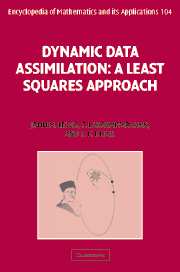Book contents
- Frontmatter
- Contents
- Preface
- Acknowledgements
- PART 1 GENESIS OF DATA ASSIMILATION
- PART II DATA ASSIMILATION: DETERMINISTIC/STATIC MODELS
- PART III COMPUTATIONAL TECHNIQUES
- PART IV STATISTICAL ESTIMATION
- PART V DATA ASSIMILATION: STOCHASTIC/STATIC MODELS
- 18 Data assimilation – static models: concepts and formulation
- 19 Classical algorithms for data assimilation
- 20 3DVAR: a Bayesian formulation
- 21 Spatial digital filters
- PART VI DATA ASSIMILATION: DETERMINISTIC/DYNAMIC MODELS
- PART VII DATA ASSIMILATION: STOCHASTIC/DYNAMIC MODELS
- PART VIII PREDICTABILITY
- Epilogue
- References
- Index
19 - Classical algorithms for data assimilation
from PART V - DATA ASSIMILATION: STOCHASTIC/STATIC MODELS
Published online by Cambridge University Press: 18 December 2009
- Frontmatter
- Contents
- Preface
- Acknowledgements
- PART 1 GENESIS OF DATA ASSIMILATION
- PART II DATA ASSIMILATION: DETERMINISTIC/STATIC MODELS
- PART III COMPUTATIONAL TECHNIQUES
- PART IV STATISTICAL ESTIMATION
- PART V DATA ASSIMILATION: STOCHASTIC/STATIC MODELS
- 18 Data assimilation – static models: concepts and formulation
- 19 Classical algorithms for data assimilation
- 20 3DVAR: a Bayesian formulation
- 21 Spatial digital filters
- PART VI DATA ASSIMILATION: DETERMINISTIC/DYNAMIC MODELS
- PART VII DATA ASSIMILATION: STOCHASTIC/DYNAMIC MODELS
- PART VIII PREDICTABILITY
- Epilogue
- References
- Index
Summary
With the advent of numerical weather prediction (NWP) in the post-WWII period of the 1950s, it became clear that numerical weather map analysis was a necessary adjunct to the prediction. Whereas a subjective hand analysis of weather data was the standard through the mid-twentieth century, the time constraints of operational NWP made it advisable to analyze the variables on a network of grid points in an objective fashion. It is worth mentioning, however, that the limited availability of computers in the early 1950s led the Norwegian weather service to prepare initial data for the one-level barotropic forecast by hand. In fact, the forecast (a 24-hour prediction) was also prepared graphically by methods that were akin to those discussed in Chapter 2 (Section 2.6). These forecasts compared favorably with the computer-generated results in the USA and Sweden. Nevertheless, by the mid-1950s, objective data assimilation via computer was the rule. We review several of these early methods of data assimilation.
In section 19.1 we provide a brief review of the polynomial approximation method with a discussion of two ways of handling the balance constraints – as strong and weak constraints. An algorithm based on Tikhonov regularization is described in section 19.2. A class of iterative techniques known as successive correction methods (SCM) is reviewed in section 19.3 along with convergence properties of these schemes. The concluding section 19.4 derives the mechanics of the optimum interpolation method and its relation to SCM.
- Type
- Chapter
- Information
- Dynamic Data AssimilationA Least Squares Approach, pp. 300 - 321Publisher: Cambridge University PressPrint publication year: 2006



